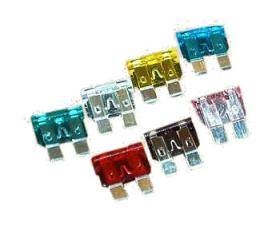
Fuses in your car have one purpose--to protect your electrical system in the event of a power surge or short circuit. The small devices are inexpensive, easy to locate and can be replaced by even the most mechanically challenged of drivers in a matter of minutes, saving costly diagnostic and auto repair charges.
Without fuses in place, a temporary power surge or short circuit could completely disable the electrical system in your car resulting in major repair bills. If your lights won't come on even after you have replaced the bulb, your horn doesn't blow, your radio doesn't play, your electric windows won't roll down or your air conditioner won't blow, there is a good chance that you have a blown fuse. Checking the fuses first, before taking the car to the shop, can save time, money and frustration.
Car fuses act like the circuit breakers in your house to protect the electrical currents in your car. Every component in your car that uses electricity relies on a fuse as a bridge between itself and the power source. Most fuses handle the load for several different powered objects. One fuse may channel power to the radio, emergency flashers and brake lights. All fuses are rated for a specific amperage and a fuse cannot channel more that that amount of power.

There are two basic types of automobile fuses--the glass tube type and the blade type. Cars manufactured prior to 1980 are likely to be fitted with the glass tube type of fuses. These fuses look like elongated glass cylinders, generally around 1-inch long with a metallic cap on each end. A fine filament can be seen inside the tube connecting the two caps. Newer versions were made from plastic. The blade type of fuse is used almost exclusively on newer models. These fuses have a plastic, color coded cap with two blades that fit into a slot in the fuse box. A metallic connecting line, or bridge, runs between the two blades and is visible through the plastic cap.
Both the glass tube and blade type of fuses have their amperage ratings imprinted on them. The blade type is also color coded to make it easier to determine its amperage rating. When the fuses are in proper operating condition, the connecting filament will be intact. When a fuse is blown the filament or connecting bridge will be broken. A darkening around the ends of a glass tube fuse may also indicate a blown fuse.

Any time an electrical component fails to operate and there is no obvious reason, it is time to check the fuses. The fuses are located in the car's fuse box which could be located under the dash, under the hood, or in any number of unlikely locations. The only way to be sure is to check your owner's manual. Many cars have more than one fuse box. Fortunately, most fuse boxes have a schematic printed on their cover to let you know which fuse handles each device. Always replace fuses with another fuse of the same amperage rating. In an emergency it is possible to replace the fuse of in important component, for instance your headlights, with a lesser component like your radio, until you can get to an auto parts store and purchase a replacement.